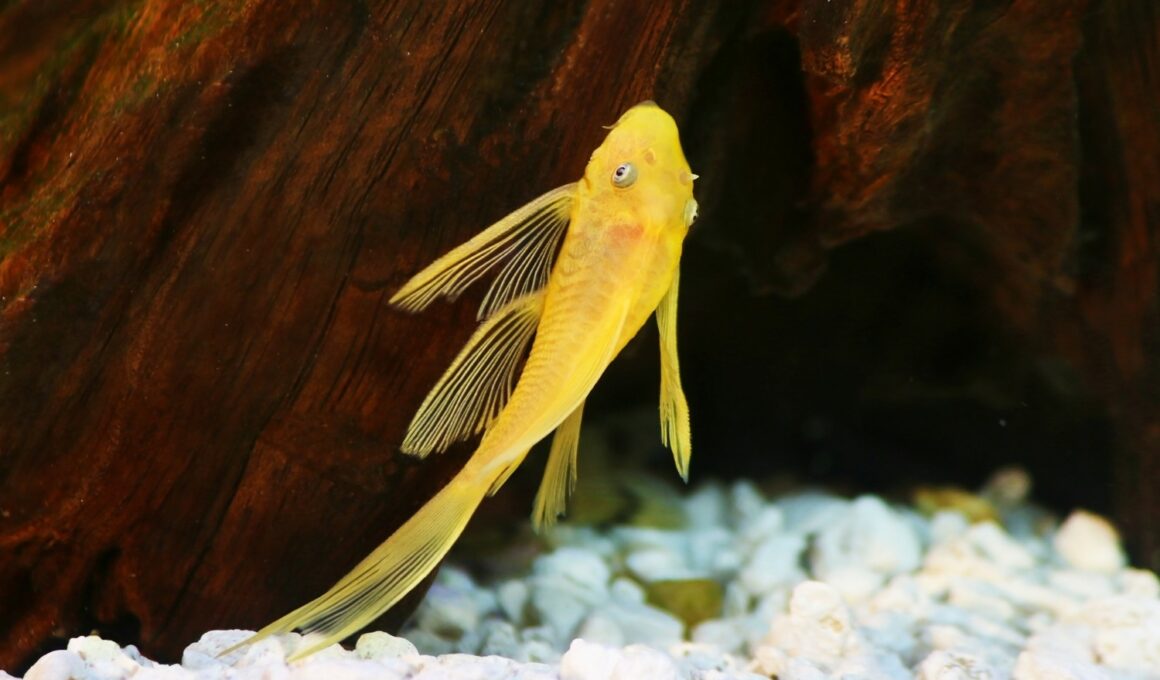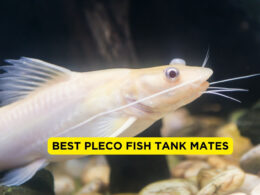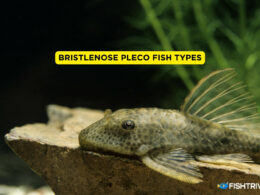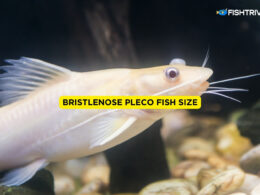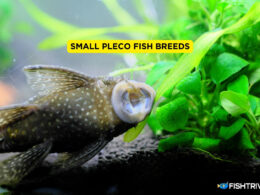In this article Show
If you’re fascinated by plecos, chances are you’ve either added a pleco to your freshwater tank or are seriously considering it. A staple in many home aquariums, plecos, with their unique armor-like appearance and intriguing behavior, is certainly a sight to behold.
But remember, while they’re often sought after for their algae-eating tendencies, these fish have needs that extend beyond just keeping your tank’s glass clean. Over my years as an aquarist, I’ve come to appreciate the nuances of pleco care.
While they might not be the most demanding of aquatic pets, there are certain aspects of their habitat, diet, and lifestyle that, when fine-tuned, can make their stay with you both enriching and lengthy.
Through this guide, I’ll share essential pleco care tips, backed by my hands-on experience, ensuring your finned friend doesn’t just survive but truly thrives.
Whether you’re a newbie just setting up your first tank or a seasoned fish keeper looking to expand your knowledge, let’s dive in and explore the fascinating world of plecos together.
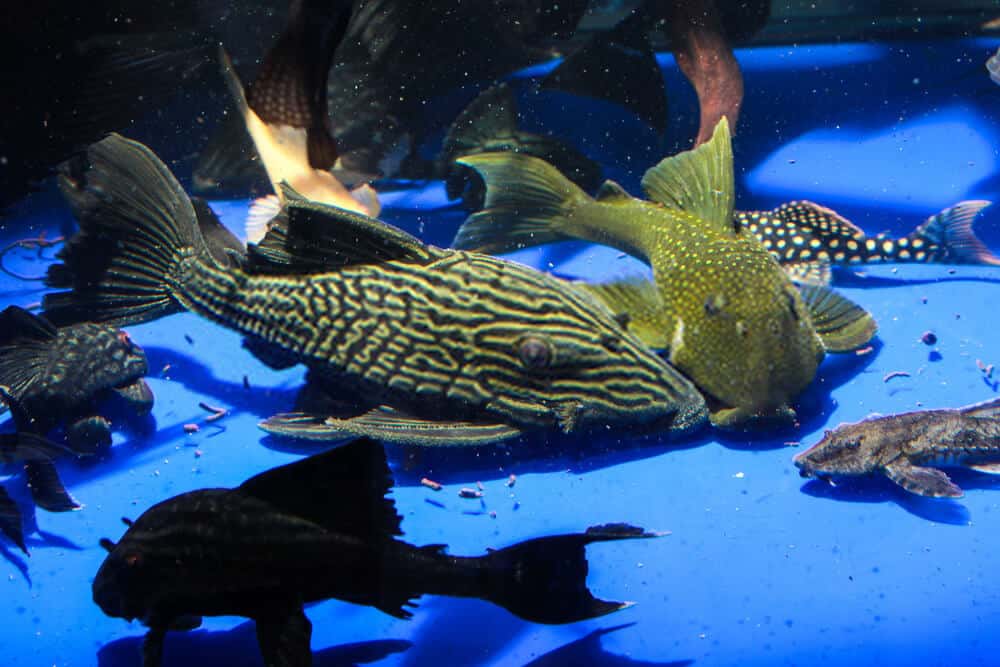
Pleco Basics
When most people think of plecos, they often visualize that quintessential fish stuck to the aquarium glass, gracefully nibbling away. But there’s so much more to these intriguing creatures than first meets the eye. Let’s unpack some of their fundamentals:
1. Scientific Classification
- Order: Siluriformes
- Family: Loricariidae
It’s worth noting that while “pleco” is a colloquial term widely adopted by fishkeepers, it’s a condensed reference to the vast family of Loricariidae, housing numerous species.
2. General Appearance and Characteristics
Plecos are armored catfish, a distinction owed to the bony plates covering their bodies. These plates, combined with their elongated structure, give them a prehistoric look, reminiscent of miniature aquatic dinosaurs. Here are a few distinguishing features:
- Mouth: They possess a suction-cup-like mouth, which they often use to cling to surfaces and consume algae.
- Eyes: Plecos have small eyes that can appear almost camouflaged against their body coloring.
- Body: Their body colors and patterns can vary greatly depending on the species but commonly range from browns, and grays, to even greens, often adorned with patterns, spots, or stripes.
3. Types of Plecos
Common Pleco (Hypostomus plecostomus)
This is likely the species many envision when thinking of plecos. They can grow quite large and are known for their adaptability.
Bristlenose Pleco (Ancistrus spp.)
A smaller variant, recognizable by the ‘bristles’ or ‘whiskers’ on their snout. Perfect for those with medium-sized tanks.
Clown Pleco (Panaqlus maccus)
Recognized by their striking patterns, these plecos remain relatively small and are more wood-centric in their diet.
Zebra Pleco (Hypancistrus zebra)
Boasting beautiful black and white stripes, they are a sought-after species, often requiring slightly warmer waters.
Royal Pleco (Panaque nigrolineatus)
With a majestic appearance, these fish can grow quite large and have a diet that leans heavily on wood.
It’s crucial to note that the pleco world is vast, with many species available in the aquarium trade. Before making a choice, always research the specific needs, size, and behavior of the species you’re interested in.
Tank Setup for Plecos
The tank setup – the crux of ensuring your pleco feels right at home. Properly setting up your aquarium not only guarantees a comfortable environment for your fish but also significantly impacts their overall well-being. Let’s break down the essentials:
1. Tank Size and Dimensions
Plecos, depending on the species, can range from a manageable 4 inches to a whopping 24 inches in size!
For smaller species like the Bristlenose Pleco, a 30-gallon tank might suffice. However, for larger species like the Common Pleco, you’d be looking at a minimum of 75 gallons, with many enthusiasts recommending even larger setups.
Remember, plecos are active swimmers, especially at night. The more space, the better – not just for growth but also for exploration.
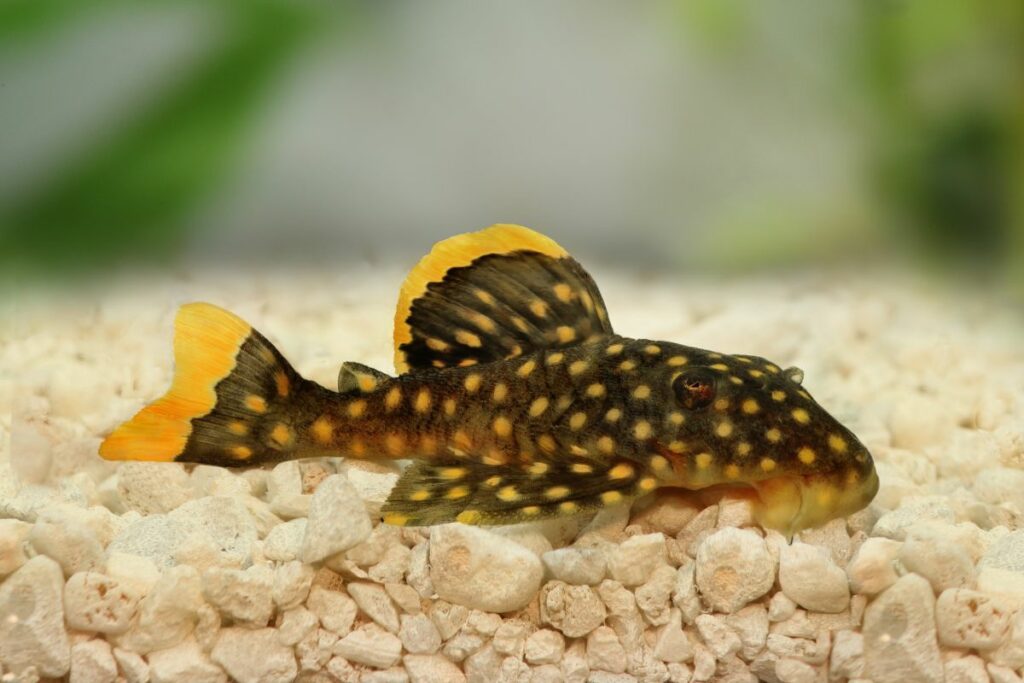
2. Substrate and Decor
Plecos are bottom dwellers, making your choice of substrate and tank decorations essential.
- Substrate: Fine sand or small-grain gravel is often recommended. This ensures plecos can sift through without harming themselves.
- Hiding Spots: Plecos are shy by nature and adore their privacy. Ensure your tank has adequate caves, driftwood, and rock formations for them to hide and rest.
- Plants: While not a necessity, plants can offer additional hiding spots and enhance the tank’s aesthetics. However, be prepared for occasional uprooting if your pleco decides to redecorate!
3. Water Parameters
Plecos are hardy, but they, like all fish, thrive best when their specific water parameters are met.
- pH: A slightly acidic to neutral pH, typically between 6.5 to 7.5, is ideal for most species.
- Hardness: Soft to medium water hardness.
- Temperature: Depending on the species, a range of 74°F to 80°F (23°C to 27°C) is standard.
- Filtration: Given their size and waste production, a robust filter is crucial. Canister filters or hang-on-back filters with adequate turnover rates are popular choices. Additionally, plecos appreciate a moderate current in the water.
4. Tank Mates
While plecos are generally peaceful, their compatibility can hinge on several factors.
- Compatible Species: Tetras, rasboras, mollies, and guppies often make great companions. For a larger tank, angelfish, discus, and cichlids can also coexist harmoniously with plecos.
- Incompatible Species: Avoid aggressive or highly territorial species. Similarly sized or larger territorial fish can also spell trouble.
- Pleco with Pleco: While some plecos can cohabitate, be cautious of mixing large species or those with territorial tendencies, especially in limited space.
Diet and Feeding
One common misconception about plecos is that they’re solely algae eaters and can subsist on just the green growth in your tank. While they do enjoy algae, a balanced diet is key to their vitality. Let’s explore their dietary needs in detail:
1. Overview of Their Omnivorous Diet
Despite their affinity for algae, plecos are omnivores, which means their diet includes both plant and animal matter. Feeding them a diverse diet ensures they receive all necessary nutrients and minerals.
2. Primary Foods
- Algae Wafers: A staple for many pleco owners, these wafers sink to the bottom, making them easily accessible. They offer a good balance of nutrients and are formulated specifically for bottom feeders.
- Sinking Pellets: These can be vegetable-based or contain a mix of protein sources, catering to the omnivorous nature of plecos.
- Fresh Veggies: Plecos love vegetables! Blanched zucchini, cucumber, spinach, and peas are favorites. Remember to remove any uneaten veggies after 24 hours to prevent water fouling.
3. Supplementary Foods
While primary foods can make up the bulk of their diet, it’s beneficial to offer supplementary foods occasionally.
- Protein Sources: Live or frozen foods such as bloodworms, brine shrimp, or daphnia can be offered once in a while.
- Wood: Certain pleco species, especially those from the Panaque genus (like the Royal Pleco), require wood in their diet. They’ll gnaw on driftwood, aiding digestion and providing essential nutrients.
4. Feeding Frequency and Amount
- Frequency: Daily feeding is typical for most plecos. However, the amount and type of food might vary based on the fish’s size and activity level.
- Amount: A good rule of thumb is to offer an amount they can consume within 2-3 hours. If you find excess food after this time, consider adjusting the portion in subsequent feedings.
5. Importance of a Varied Diet for Optimal Health
A monotonous diet can lead to nutrient deficiencies. Regularly rotating foods and offering a mix ensures a well-rounded intake. Not only does this promote health, but it also keeps the pleco interested and stimulated by the variety.
Pleco Lifespan and Health
Plecos, like any other fish, require attentive care to ensure they lead a long, healthy life. Recognizing the potential lifespan of your pleco and understanding common health issues will empower you as an aquarist to provide the best possible environment.
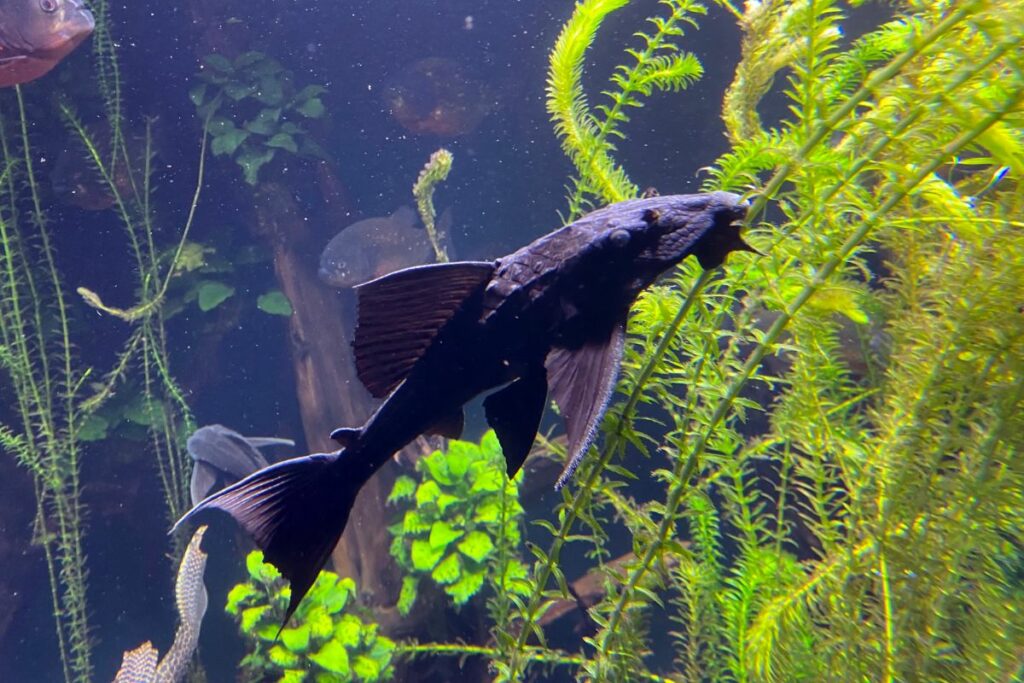
1. Average Lifespan in Captivity
Depending on the species and care provided, plecos can live for quite a while! Bristlenose Plecos, Clown Plecos, and other smaller species typically have a lifespan of 5-10 years.
While larger plecos such as Common Plecos and their kin, with the right care, can live for 10-15 years, and in some cases, even longer!
2. Common Health Issues and Their Prevention
Malnutrition
A varied diet is crucial. Solely relying on tank algae or low-quality food can deprive them of essential nutrients.
Parasitic Infections
White spots, lethargy, or loss of appetite can indicate a parasitic issue. Maintaining good water quality and quarantining new tank additions can help prevent this.
Skin and Fin Issues
Cuts, ulcers, or fraying fins might result from poor water quality, sharp tank decorations, or aggressive tank mates. Ensure regular water changes and provide a safe environment.
Bloating
Overfeeding or internal parasites can cause bloating. Regular, small feedings and occasionally including foods with antibacterial properties (like garlic) can help.
3. Regular Water Changes and Tank Maintenance
Water Changes
Regularly changing 20-30% of the tank water every 1-2 weeks helps in maintaining optimal water parameters, crucial for the health of plecos and other tank inhabitants.
Filter Maintenance
Given that plecos produce a substantial amount of waste, cleaning and ensuring your filter runs efficiently is paramount.
Water Testing
Periodically testing the water for ammonia, nitrites, nitrates, and pH can alert you to potential issues before they become critical.
4. Monitoring and Observation
One of the most valuable tools in ensuring the health of your pleco is simply observation. Taking a few minutes daily to watch your pleco can help you detect any anomalies in behavior or appearance, giving you a head start in addressing potential issues.
Breeding Plecos
Breeding plecos can be a fulfilling experience, watching them court, lay eggs, and then observing the tiny fry grow. If you’re interested in breeding these armored catfish, understanding their breeding habits and providing the right conditions is crucial. Let’s dive into the world of pleco propagation.
1. Breeding Behavior and Triggers
Before breeding, you may notice increased activity, especially during the evening or night. Males may become territorial, guarding their chosen breeding spots.
A change in water temperature, simulating the rainy season by introducing cooler water, can induce breeding behavior. Additionally, increased water flow or a slight drop in atmospheric pressure (akin to an impending rainstorm) can also serve as triggers.
2. Setting Up a Breeding Tank
Tank Size
A separate breeding tank is advised. For smaller species, a 20 to 30-gallon tank can suffice. Larger species may require more space.
Substrate
Fine sand or small-grained gravel ensures safety for the eggs and allows parents to sift through.
Hiding Spots
Breeding caves or PVC pipes work well, giving the male a spot to guard and the female a safe place to lay her eggs.
Water Parameters
Maintain slightly acidic to neutral pH levels (around 6.5-7.5) and a temperature conducive to the specific pleco species.
3. Choosing and Preparing the Breeders
Only mature, healthy plecos should be chosen for breeding. Typically, plecos reach breeding maturity at 1-2 years, though this varies by species. In the lead-up to breeding, provide a high-quality, varied diet to ensure the fish are in optimal condition.
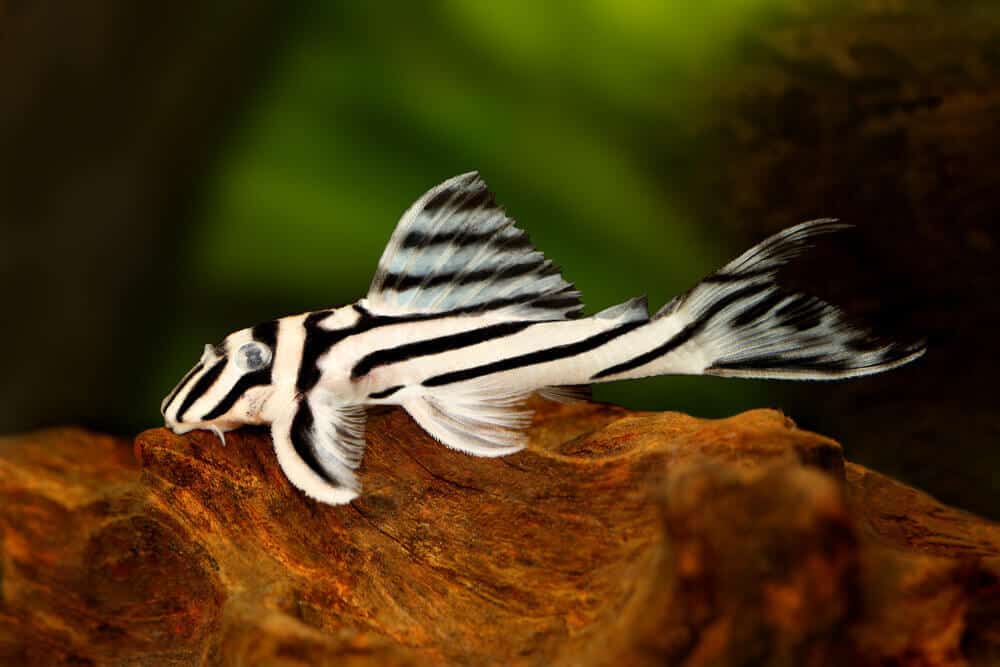
4. The Breeding Process
Courtship
The male will often guard his chosen spot, trying to lure the female in. There’s a display of fanning, chasing, and even some playful nips.
Egg-Laying
Once the female enters the cave or chosen spot, she’ll lay her eggs, which the male subsequently fertilizes. The female then leaves, and the male takes over guarding and fanning duties, ensuring oxygen supply and preventing fungus formation on the eggs.
Egg Development
Depending on the species and water temperature, eggs usually hatch within 5-10 days.
5. Fry Care and Feeding
Initial Days
Post-hatching, the fry will feed on their yolk sacs for a few days. After this, they’ll venture out in search of food.
Feeding
Initially, offer finely crushed algae wafers or specialized fry food. As they grow, you can introduce finely chopped veggies and gradually transition to a regular pleco diet.
Safety
Ensure the breeding tank has no predatory fish. Regular water changes and maintaining pristine water quality are vital at this stage.
6. Growth and Transition
Once the fry has grown a bit and are robust, they can be slowly introduced to the main tank or moved to larger grow-out tanks.
Frequently Asked Questions
Do plecos eat other fish?
Typically, plecos are peaceful and won’t harm other fish. They are bottom feeders and mostly eat algae and the food provided to them. However, if a fish is already sick or dying and is lying at the bottom, a pleco might nibble on it. It’s essential to keep an eye on tank dynamics and ensure all fish are healthy.
How often should I clean the tank with a pleco inside?
Plecos, especially larger species, produce a significant amount of waste. Regular maintenance is essential. Conduct 20-30% water changes every 1-2 weeks, and ensure the filter is clean and running efficiently. Monitor the tank for any uneaten food or waste and remove it promptly.
Can I keep multiple plecos in the same tank?
Yes, but with some caveats. The tank’s size, the pleco species, and their individual temperaments play roles.
Larger tanks can accommodate multiple plecos better, given each has sufficient space and hiding spots. Some species are more territorial than others, so it’s essential to know your pleco’s behavior and ensure they’re compatible.
Will my pleco eat all the plants in my tank?
Plecos are primarily algae eaters, but some might nibble on soft plants. If you notice plants being eaten, consider offering more vegetables in their diet or switching to hardier plant species.
Conclusion
Plecos, with their captivating presence, are a rewarding addition to any aquarium. By understanding their specific needs, from tank setup to diet and beyond, you can ensure a happy, healthy life for these intriguing bottom-dwellers. Remember, attentive care and a pinch of passion go a long way in the world of aquatics.






